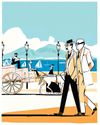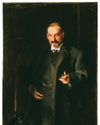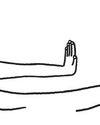
Half a century later, they still return our gaze, staring back at us in their dark dresses and white stockings, their white headbands pinned in place. The seven-year-old identical twins Cathleen and Colleen Wade stand side by side, pressed together as if to create the illusion that they are conjoined. One twin smiles; the other appraises the photographer. There are remnants of chocolate cake in the creases of their mouths.
Diane Arbus took this portrait, "Identical twins, Roselle, N.J. 1966," at a Christmas party for families of multiples held at a Knights of Columbus hall. She'd been lurking at such events, prospecting for twins and triplets. Through her view-finder, the sisters appear less like two separate children than like split aspects of the same soul, simultaneously innocent and foreboding. "I mean, it resembles them," their father told a reporter at a 2005 retrospective of Arbus's work. "But we've always been baffled that she made them look ghostly. None of the other pictures we have of them looks anything like this."The photograph reportedly inspired Stanley Kubrick's depiction of the eerie sisters in "The Shining." In "How to Be Multiple: The Philosophy of Twins" (Bloomsbury), Helena de Bres aims to rescue twins from the gothic, from horror movies, and from singleton scrutiny, the better to return
This story is from the January 29, 2024 edition of The New Yorker.
Start your 7-day Magzter GOLD free trial to access thousands of curated premium stories, and 9,000+ magazines and newspapers.
Already a subscriber ? Sign In
This story is from the January 29, 2024 edition of The New Yorker.
Start your 7-day Magzter GOLD free trial to access thousands of curated premium stories, and 9,000+ magazines and newspapers.
Already a subscriber? Sign In

BADDIE ISSUES
\"Wicked\" and \"Gladiator II.\"

LET'S MAKE A DEAL
\"Death Becomes Her\" and \"Burnout Paradise.\"

ANTI HEROES
\"The Franchise,\" on HBO.

FELLOW-TRAVELLERS
The surprisingly sunny origins of the Frankfurt School.

NOW YOU SEE ME
John Singer Sargent's strange, slippery portraits of an art dealer's family.

PARIS FRIEND - SHUANG XUETAO
Xiaoguo had a terror of thirst, so he kept a glass of water on the table beside his hospital bed. As soon as it was empty, he asked me to refill it. I wanted to warn him that this was unhealthy - guzzling water all night long puts pressure on the kidneys, and pissing that much couldn't be good for his injury. He was tall, though, so I decided his insides could probably cope.

WILD SIDE
Is Lake Tahoe's bear boom getting out of hand?

GETTING A GRIP
Robots learn to use their hands.

WITHHOLDING SEX FROM MY WIFE
In the wake of [the] election, progressive women, who are outraged over Donald Trump's victory at the ballot box, have taken to social media with public, vengeful vows of chastity. - The Free Press.

DEADLINE EXTENSION
Old age, reborn.